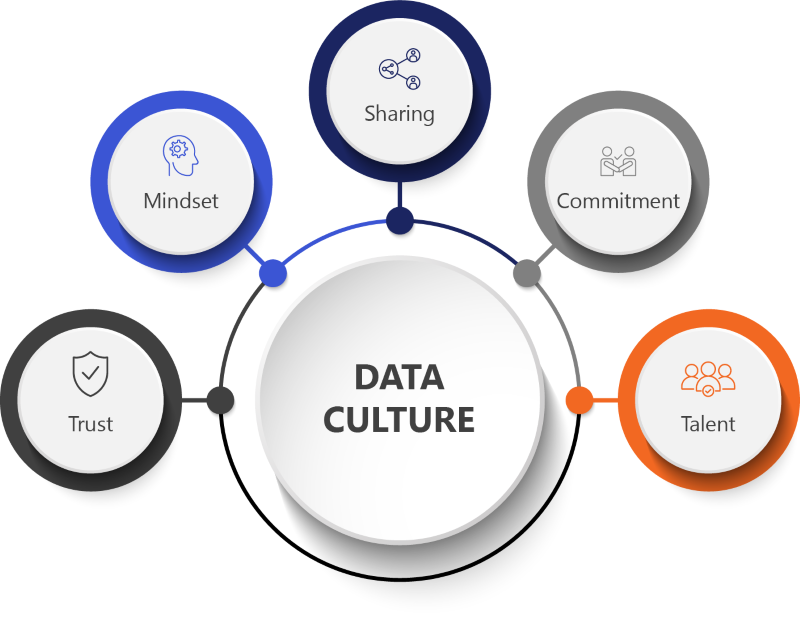5-minute read
This is the second article in a two-part series about building a culture around data influence. Click here to read Part 1.
In the first article in this series, we explored the evolution of decision making—from purely intuitive to purely data-riven—and presented data influence as an optimal solution that leverages the strengths of both. In this article, we’ll dig deeper into the key necessities for creating a data culture that supports data influence and provide actionable steps for getting started.
Building a strong data culture to support data influence
Adopting data influence requires more than a change in decision-making processes—it demands a robust data culture that integrates analytics and human judgment at every level. A strong data culture enables organizations to align their people, processes, and technology to fully realize the benefits of data influence.
Key pillars of data influence culture
Building a culture around data influence involves focusing on five critical areas:
Trust
Confidence in the accuracy and applicability of data is essential. Without trust, decision makers will hesitate to rely on analytics, undermining the effectiveness of data-driven insights. Clear data governance, validation processes, and transparent methodologies help establish this trust.
Mindset
A successful data culture requires a mindset that values both human and data-driven insights. Championing this mindset requires leadership to model data-informed decision making while recognizing the importance of intuition and expertise.
Sharing
Democratizing data access ensures that decision makers at all levels have the tools and information they need. By breaking down silos and providing user-friendly platforms, organizations empower employees to leverage data in their roles.
Commitment
Long-term investment in data systems, data literacy programs, and infrastructure is non-negotiable. This commitment demonstrates the organization’s dedication to embedding data influence as a core capability, rather than treating it as a one-time initiative.
Talent
Bridging the gap between technical and business teams requires building data literacy across the organization. Upskilling employees ensures they can understand, interpret, and apply data effectively in their decision-making processes.

Practical considerations
While the pillars of data influence set the foundation, practical challenges often arise in implementation. Addressing these considerations is key to building a sustainable data culture:
Balancing data democratization and data hygiene
Organizations must navigate the trade-off between providing widespread access to data and ensuring its quality. Greater democratization empowers decision makers but can introduce inconsistencies or errors if data isn’t properly governed. Establishing clear ownership, validation processes, and tiered access can strike the right balance.
Avoiding magical thinking
Tools like generative AI hold enormous promise but require thoughtful application. Blindly trusting algorithms or deploying AI without clear objectives risks compounding errors or producing misleading results. Organizations must ensure that AI tools are seen as aids, not replacements, for human judgment.
By addressing these practical considerations, organizations can create a strong data culture that supports data influence, enabling them to make smarter, more balanced decisions that combine the best of human intuition and analytics.
How to get started
Building a culture around data influence is a journey that requires deliberate steps to align your organization’s people, processes, and technology. Here’s are some proven measures for building momentum and setting the foundation for success:
Conduct a current-state assessment
Start by evaluating where your organization stands in terms of data culture, infrastructure, and processes. Assess your decision-making models and identify areas where data is underutilized or misaligned with organizational goals.
Identify gaps in data literacy, processes, and organizational alignment
Pinpoint challenges that hinder the effective use of data, such as:
- Low data literacy among employees
- Inefficient or inconsistent processes for collecting, analyzing, and sharing data
- Misalignment between leadership’s data expectations and employees’ capabilities
Focus on high-impact, low-effort initiatives
Prioritize initiatives that deliver tangible benefits quickly without requiring excessive resources. These projects build credibility and enthusiasm for data influence while demonstrating its potential.
Start with targeted use cases to demonstrate quick wins
Select specific use cases that address clear business needs. Examples include:
- Product roadmap analysis: Use data to identify features with the highest potential for market impact.
- Workforce planning: Leverage analytics to forecast staffing needs and predict attrition rates.
Demonstrating success in these areas builds momentum for larger initiatives.
Encourage collaboration through tools and practices
Adopt tools and workflows that promote cross-functional collaboration and empower employees to make informed decisions. By aligning processes and systems, teams can more easily access and apply insights in their roles.
Build dashboards and insights designed with user experience in mind
Create intuitive, visually compelling dashboards tailored to the needs of specific teams. By focusing on usability, you can foster trust in the data and encourage adoption across the organization.
Promote data literacy as a foundation
Invest in data literacy programs to bridge the gap between technical teams and business users. Ensure that all employees:
- Understand how to interpret and apply data insights.
- Have confidence in the tools and methodologies being used.
Ensure teams trust and understand the data
Cultivate trust by improving data quality, transparency, and relevance. As employees grow more comfortable working with data, they’ll develop the confidence needed to integrate it into their decision-making processes consistently.
The power of balance in a data-obsessed world
As organizations continue to grapple with the complexities of modern decision making, one truth becomes clear: the future belongs to those who embrace balance. Data influence is not just a methodology—it’s a mindset shift, one that demands the integration of evidence with intuition, automation with creativity, and technology with humanity.
To truly unlock the potential of data, organizations must think beyond tools and systems. Building a culture of data influence means empowering people to ask the right questions, trust their instincts, and use data as a compass—not a crutch.
The takeaway is simple yet profound: the strongest decisions are not the ones dictated solely by data or intuition but those crafted by leveraging the strengths of both. Leaders who prioritize this balance will not only improve outcomes, but also foster innovation, resilience, and trust across their organizations.
Data influence is a journey, not a destination, and every small step toward balance brings your organization closer to making decisions that are smarter, more sustainable, and more human. Now is the time to start.

Empower employees with data literacy
Logic20/20 applies our proven change management process to ensure alignment among leaders, stakeholders, and users in designing and executing effective data literacy programs.
- Strategic vision of data culture
- Initial assessment
- User adoption
- Continuous improvement

Mick Wagner is responsible for leading the Advanced Analytics Practice to exceed client expectations, develop innovative solutions, and achieve organizational growth. Mick has over 15 years of data analytics consulting experience across the full BI lifecycle.

Matt Kieffer brings over a decade of expertise in the energy and technology industries to his role as Manager in Logic20/20’s Advanced Analytics practice. He specializes in transforming complex data into actionable business insights, driving measurable outcomes such as cost savings, process efficiencies, and improved performance metrics.


